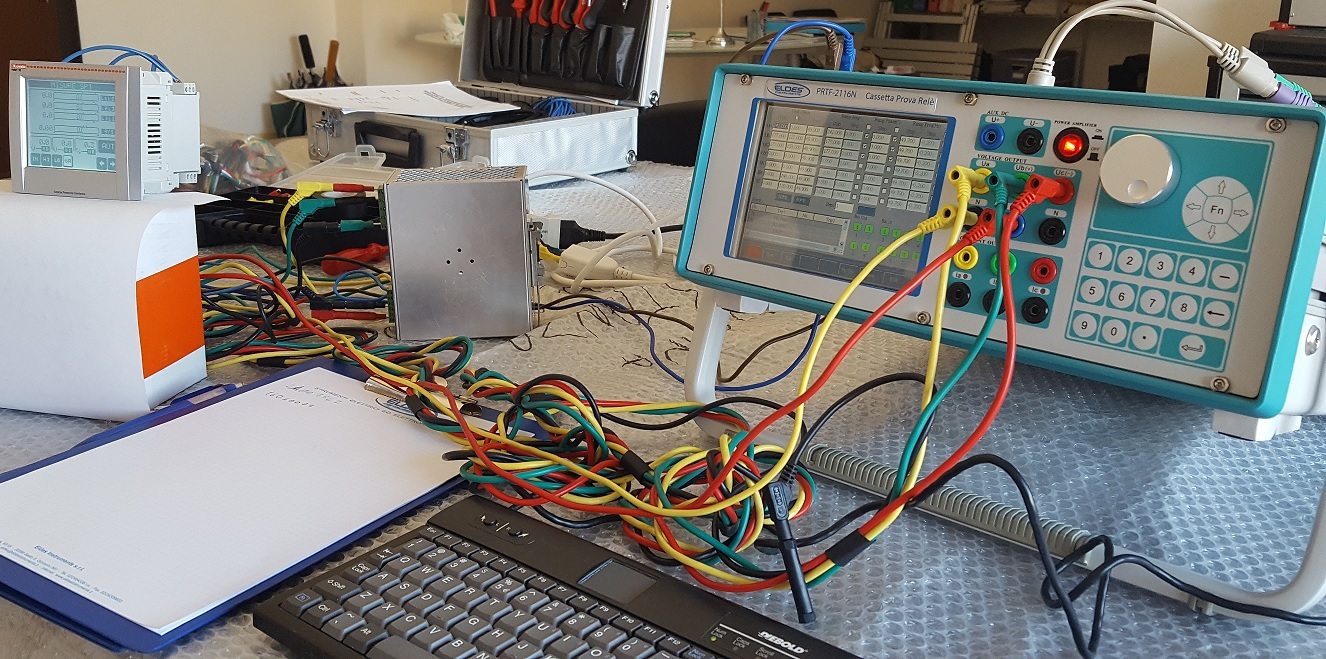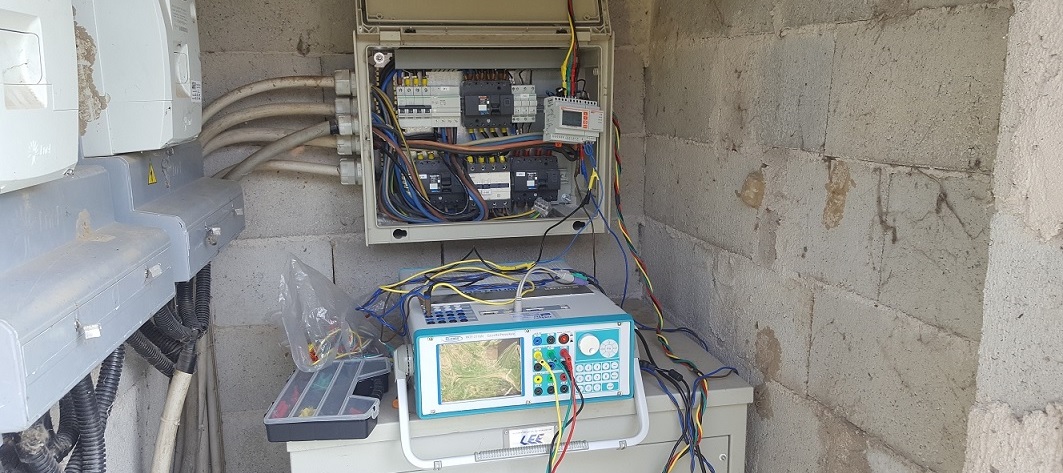
| Home SunSim |
| SunSim Storage |
| Other SW & Info |
| Studio Tecnico Groppi |
| Articles |
| Conferences |
| Awards |
STUDIO TECNICO GROPPI
Studio tecnico Ing. Groppi - Project Management Professional - PMP(R)
Via Locati, 3 - 29121 Piacenza - Italy
Tel/Fax: +39 0523 490771
e-mail: groppi@sunsim.it


Protection' Test on Field and Laboratory

How often?
A check of the correct functioning for the power production systems connected to LV and MV grid must
be done every 5 years with a proper relay tester (in addition to the initial test
at the time of commissioning of the system).
These tests concern both the General Protection System (SPG) and the Inteface
Protection System (SPI).
In fact, the CEI 0-21 (LV) at par. G.5 states than "The active user is committed to
maintain efficient the general and interface protection systems and to test their functionality
and their compliance to the requirements of the Distributor as regards the set-points of the
thresholds by means of a preliminary check at connection and, later, with a check every 5 years,
by testing, by means of the relay tester, all the functionalities of the protections, inclusive of
the tripping times of the switches".
The CEI 0-16 (MT-AT), for its part, in the amendment V2 at par. 8.5.12.1 states that
"The User and the Distributor are both responsible of the proper working of their protection systems
that must be properly maintained and periodically tested [...] every 5 years by testing, by means of
a relay tester, all the functionalities of the protections, inclusive of the tripping times of the
switches". Furthermore, a site inspection is required "every year, by visually checking the
set-points of the protections".
But we must also add that, as regards existing systems, the Operation Agreement may have
specified a more frequent detailed basis for periodic testing (typically three years, in accordance
with the old standards).
It is really useful to test protections on field?
It is a controversial topic, because, according to some, the protection testing, although mandatory,
is actually a waste of time which results in an unnecessary cost to the customer.
although I am quite critical of some technical choices included in the standards CEI 0-21 and CEI 0-16,
in my opinion the test of protections on field is something always useful and also necessary in a
few cases for the following reasons:
- In case of new installations, the set-point values of thresholds as regulated by
the manufacturer of the equipment (protection relay) not always coincide with those desired.
This because manufacturers not always adjust calibrations with the values presently contained in
the standards, and more frequently because the set-point values required by the Operation Agreement
could be different from those reported in standards. The verification of the equipment as a whole
by means of tests on field ensures that its behavior will be exactly the one you want.
- Especially in case of MV interface protections, the functional requirements are quite
complex (voltmetric release, moving average...) and not infrequently difficult to comprehend
also for the same technicians who shall install the equipment (it could be useful the program
Trefasi freely downoadable in the section Other SW & Info).
Consequently, the on field test ensures that the installation and all adjustments have been
properly made.
- It may seem strange, but in installations in function sometimes one find excluded or
tampered protections due to carelessness, neglect, lack of maintenance, etc. (I will not
consider the fraud that needs a separate discussion). A few years ago it happened to find in a
medium manufacturing company the entire general protection system completely disconnected and thus
inoperative without anyone had noticed! it is therefore understandable that the standardization
has introduced periordic tests, which should at least put a limit to the persistence of clearly
out of control situations.
The most frequent mistakes
The test of protection on field is something far from trivial. Not infrequently the protection
to be tested is located in narrow and/or dusty environments (see figure). Furthermore, the panels
where the protections are installed are sometimes overcrowded and with terminals that are difficult
to access.

When you are faced with these situations it is better to forget the rush and once more verify
the wirings to avoid incurring unpleasant consequences. An interface protection knocked out by a
wrong connection, an accidental contact, or a voltage supply too high is a very unpleasant
situation. However, it may turn into a dramatic experience if the same thing happens to a
General Protection!
More importantly: NEVER forget that their own safety and that of any employees comes first!
A mask, a pair of insulating gloves and, when needed, a helmet, often elicit the
ironic smiles among those present but, should an accident occur, they can avoid us a sad awakening
in a hospital bed with our head bandaged.
Once made these premises, let's see the most common mistakes that may occur when we are testing on
field our beloved protections.
Intervention of the threshold 59.S1 with 10 min moving average
Te test of the protection 59.S1 with a 10 min moving average is It is an operation that should be
completely simple, considering that one gives to the protection a constant value for 10 minutes and
verifies its intervention (or its non-intervention after 11 minutes).
Without dwelling on the fact that the CEI 0-16 and the CEI 0-21 describe the test differently and
that the CEI 0-16 refers to the Annex S - Informative, on which there is much to discuss, I merely
record the fact that often the response times measured take on the strangest values: 5 min, 6 min
and so on. How can you verify doing the math, rates of this type are absolutely incompatible with
the application of a voltage equal to 115% of Un, having a threshold 59.S1 adjusted to 110%
(CEI 0-16, par. E.5.2.3). Why this behavior also in case of top level brands?
The riddle is quickly revealed when you consider that, especially if tests are automatically
sequenced one after the other, very often before you proceed with the test of
non-intervention (105% of Un) and immediately after with that of intervention (115% of Un).
Consequently, the protection under test has already recorded an abundant sequence of values
higher than 5% of the nominal value Un, and now they shall be calculated in the moving average
along with the new values that are 15% higher of Un. Obviously, the resulting time of intervention
then becomes about 5 minutes (equal to the average overrun of 10% of Un on 10 minutes), since the
counting by the instrument is begun when the voltage was raised to 115% of Un.
However, this is a measure completely wrong of the intervention time (because the starting
time considered is wrong), which, however, most of the time is taken for good without many
questions. It should be also said that this superficial attitude is also partly due to the lack
of clarity from the CEI 0-16, which shortly says that the test is done "verifying that the
action occurs within 10 minutes".
Initial values not restored after temporary changes
When the General protections and the Interface protections are tested, it is necessary, sometimes,
to eliminate or adjust differently some thresholds that could interfere with others. Nowadays,
these temporary modifications are less frequent than in the past, because the modern relay testers
often allow you to work around the problem by shaping the ramps so that appropriate.
However, especially in case of General protection systems, one must inhibit a few thresholds in
order to test the others, for instance the I>> (51) to test the I>>> (50).
It is important to be sure that, when the test is finished, the characteristics of all thresholds are
properly restored, in order to avoid to compromise the functionality of the protection just tested.
A rule that should be respected in these cases is to test at the end the thresholds temporarily
modified, so be sure not to have missed anyone.
Lack of documentation (e possible lack of tests)
Both CEI 0-21 and CEI 0-16 require that the tests on voltage thresholds (59 and 27) and on frequency
thresholds, further than on residual voltage for MV connections, be made by measuring separately
thresholds and times of intervention. This means that for each threshold a ramp test (threshold
value) and a step test (time value) are necessary.
We see however, that there are cases where the accompanying documentation does not show in any way
that both measures have actually taken place, often merely and shortly reporting, for each
threshold, only two lines of text: the first related to the real "threshold" and the second related
to the "time of intervention". Those who read a report of this kind cannot therefore understand if
such a meager description refers to two different measurements, or only to the measurement of the
value of the threshold of intervention, because the latter is obviously also associated to an own
intervention time.
This questionable approach unfortunately it is partly due to the lack, in CEI 0-21 and CEI 0-16, of
indications on the minimum requirements for the test reports, but it may expose the documentation
produced to a motivated rejection by those that afterward must check its correctness and
truthfullness (Distributor & C.).
Just to make a comparison, a typical test report of the Studio Tecnico Groppi for a MV interface
protection is made of 22 pages automatically produced by the relay tester, each containing all the
parameters used and the values measured in each test, accompanied by a 6 pages test report and the
calibration certificate of the instrument.